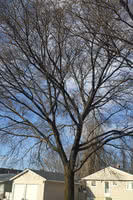Mon-Fri 9am - 5pm Mountain time
Common Hackberry vs Freedom Japanese Elm
Celtis occidentalis
Ulmus davidiana var. japonica Freedom
NOT AVAILABLE THIS SEASON - MIGHT RETURN
The Common Hackberry is a medium-sized deciduous tree that resembles the American Elm but is immune to Dutch Elm Disease. They are versatile and can adapt to a variety of growing conditions.
It produces purple-red, berry-like fruit with a large seed in the center. Both the sweet flesh, which tastes similar to dates, and the crunchy seed are edible. The fruit remains on the tree throughout the winter, offering a valuable food source for birds and other wildlife.
The Common Hackberry can also be a great addition to a pollinator garden. The tree itself is a host for the larvae of several butterfly species and the flowers provide a source of pollen and nectar.
Freedom Japanese Elm is great for anyone who doesn't have a lot of time to maintain their trees as it doesn't drop many seeds. It has beautiful dark green foliage and is resistant to Dutch Elm Disease. Instead of having an irregular and broad-shaped crown as other Japanese Elms do, the Freedom Japanese Elm has an open crown.

